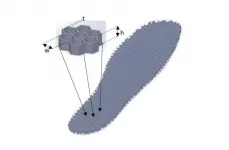(Press-News.org) Vertebrate life began in the water, but around 340-360 million years ago, four-limbed creatures, or tetrapods, made the transition onto land. In the years that followed, some species adapted to terrestrial life, while others turned back to the water and readapted to an aquatic lifestyle.
A new study of these early amphibians, published in the journal PLOS ONE and led by Penn paleontologist Aja Carter, suggests that these environmental shifts left an impression--on the shape of the animals' spines.
"I'm interested in how the shapes of the vertebrae affect how animals move," she says. "Our findings suggest that, in at least one part of the vertebrae, the shape of the bones correlated with the environment in which the animals were living." Those associations, Carter says, may be a result of the different physical demands of living on land versus in the water.
Diversity, now and then
Many characteristics distinguish creatures as diverse as humans, dogs, snakes, and even Stegasaurus, but one thing that unites them is the basic shape of their vertebrae.
"They all have this hockey puck-shaped thing, the centrum, fused to these sticky-outy parts, the neural arch, the transverse processes," says Carter, a paleontologist who earned her doctoral degree from Penn's Department of Earth and Environmental Science in the School of Arts & Sciences and is now a postdoctoral fellow in the School of Engineering and Applied Science. "But that's not always how it's been."
Go back further in evolutionary time, Carter says, starting even before dinosaurs arose, and one will find a highly diverse set of vertebral shapes. Yet it's not clear why all this diversity was present, or why vertebrates today have landed on one basic vertebral structure almost without exception.
Scientists have long debated whether a particular vertebral shape was important for these animals to colonize land or subsequently recolonize water. To explore the question, Carter focused on early amphibians, a group known as temnospondyls, which were the most diverse tetrapods living in the Carboniferous through the late Permian, or about 360 to 250 million years ago. Some lived exclusively on land, some exclusively in water, and some were amphibious. In addition, some that were known to be terrestrial had evolved from ancestors that were aquatic, and vice versa.
"If we want to understand macro-evolutionary trends, we need a lot of specimens," Carter says. "There are about 290 species of temnospondyls, and they come in different sizes, and we know a lot about them. So this was a great group to focus on."
Shapes by the numbers
Though previous studies had used qualitative techniques to assess the relationship between vertebral form and a land- or water-based lifestyle, Carter and colleagues opted to use a quantitative approach known as geometric morphometrics. This strategy quantifies shape by assigning points to the outline of a structure. In the current study, they used a two-dimenisonal approach, imagining the outline of the vertebrae viewed from the side.
The researchers focused in particular on the shape of two parts of the vertebrae, the intercentrum, a weight-bearing structure, and the neural arch, sites of muscle attachment. Many in the field presumed that a land-based lifestyle required a stiffer spine than one in water, so the team's prediction was that terrestrial temnospondyls would have longer neural arches and longer intercentra to restrict flexibility through the spine.
Yet that's not what they discovered. Instead, they found no association between the neural arches and the environment in which they animals lived. "That suggests there is some plasticity," Carter says. In other words, there is not just one type of neural arch that enables successful movement on land.
The intercentrum shape, however, did correlate with environment and not in the way that that earlier scientists had predicted. Terrestrial species tended to have shorter, more curved intercentra, while aquatic and semi-aquatic animals had intercentra that were taller and flatter.
"The intercentra are weight-bearing, and these seem to fall out based on environment," says Carter. "But the neural arches' shape don't seem to bend to the constraints that we think of in terms of terrestrial versus aquatic."
Indeed, in terrestrial species, the researchers found some with a high degree of spinal flexibility, contrary to previous beliefs, Carter says. "In fact, in our results, a lot of terrestrial taxa seemed to have spines that were a lot less stiff than their aquatic counterparts."
In addition, aquatic species that were known to have ancestors that had lived on land maintained morphologies more akin to their terrestrial counterparts. "They don't go back," she says.
Questions for the future
Carter notes, however, that there are other ways to gain spinal flexibility, including increasing the total number of vertebrae, but the new findings still buck earlier notions of what morphologies enabled a successful move to the land.
"This tells us there is more diversity than what these labels--terrestrial, aquatic--are saying, when it comes to vertebral composition and shape," Carter says.
Carter acknowledges that paleontological studies such as these leave a lot of room for doubt. Measurements are coming from fossils that may have been reshaped during the fossilization process, for example. Plus, muscle attachments, lost to the fossilization process, would have a significant impact on movement. So she won't be surprised if future studies challenge these findings.
"Science is both iterative and overturned all the time," she says.
Yet in the not-so-distant future, in her new position at Penn Engineering, Carter hopes to build paleontologically inspired robots in which she could test how differently formed vertebrae impact funcational movement.
"I'm learning that's going to be a difficult challenge, but I'm excited to work on it," she says.
INFORMATION:
Aja Carter is a Vice Provost Postdoctoral Fellow for Academic Diversity in the University of Pennsylvania School of Engineering and Applied Science.
Carter's study coauthors were Temple University's S. Tonia Hsieh and Penn's Lauren Sallan and Peter Dodson.
WEST LAFAYETTE, Ind. - Purdue University engineers have developed a method to transform existing cloth items into battery-free wearables resistant to laundry. These smart clothes are powered wirelessly through a flexible, silk-based coil sewn on the textile.
In the near future, all your clothes will become smart. These smart cloths will outperform conventional passive garments, thanks to their miniaturized electronic circuits and sensors, which will allow you to seamlessly communicate with your phone, computer, car and other machines. This smart clothing will not only make you more productive but also check on your health status and even call for help if you suffer an accident. The reason why this smart clothing ...
As many as 450,000 Americans die every year from a sudden, fatal heart condition, and in slightly more than one in ten cases the cause remains unexplained even after an autopsy. Researchers from the University of Maryland School of Medicine (UMSOM) and their colleagues found that nearly 20 percent of patients with unexplained sudden cardiac death - most of whom were under age 50 - carried rare genetic variants. These variants likely raised their risk of sudden cardiac death. In some cases, their deaths may have been prevented if their doctors had known about their genetic predisposition to heart disease. The study findings were published ...
WASHINGTON--After their initial blast, space rockets shoot away from the Earth with rumbles in infrasound, soundwaves too low to be heard by human ears that can travel thousands of miles.
New research used a system for monitoring nuclear tests to track the infrasound from 1,001 rocket launches. The research identified the distinctive sounds from seven different types of rockets, including the Space Shuttles, Falcon 9 rockets, various Soyuz rockets, the European Space Agency's Ariane 5, Russian Protons and several types of Chinese Long March rockets.
In some cases, like the Space Shuttle and the Falcon 9, the researchers were also able to identify the various stages of the rockets' journey.
https://youtu.be/IfMtEcNkkho
The ...
Smokers needed their blocked arteries fixed nearly a decade earlier than non-smokers, and patients with obesity underwent these procedures four years earlier than non-obese patients, according to a new statewide study.
The research included patients without a history of heart attack who were treated at hospitals across Michigan participating in BMC2, the Blue Cross Blue Shield of Michigan Cardiovascular Consortium. The patients had undergone angioplasty and/or stenting to widen or unblock their coronary arteries and restore blood flow. Almost all of them had at least one traditional ...
Millions of people with diabetes are at risk of developing foot ulcers, which often lead to amputations and other health complications. Now, Scientists from the Centre for Biomechanics and Rehabilitation Technologies (CRBT) have developed a new method to reliably detect this risk without the need for complex electronic in-shoe sensors.
Dr Panagiotis Chatzistergos, Associate Professor in Orthopaedic Biomechanics, explained: "In the UK alone, 169 people have a toe, foot or limb amputated as a result of diabetes every week, yet importantly up to 80% of these amputations could have been prevented with correct management.
"Routine overloading ...
New research shows what is often assumed to be 'fair' in conservation practice may not be considered so by the very people most affected by it--and a new approach is needed if protected areas are to be effective.
Lead author Dr Georgina Gurney, from the ARC Centre of Excellence for Coral Reef Studies based at James Cook University, said considering local stakeholder conceptions of fairness in conservation is critical.
"If conservation is perceived as unfair it can lead to conflict, undermining support and cooperation," Dr Gurney said.
She said it is not only an ethical matter but key to achieving good ...
University of Illinois Chicago researchers studying birth outcomes in marmoset monkeys found there were no adult maternal characteristics like age or weight gain during pregnancy to predict stillbirth or early neonatal death, but that a mother's birth weight or litter size were associated with early neonatal death.
"Our findings of early life contributions to adult pregnancy outcomes in the common marmoset disrupt mother-blaming narratives of pregnancy outcomes in humans," the paper states.
Julienne Rutherford, associate professor at UIC's School of Nursing, is lead author of "Womb to Womb: Maternal litter size and birth weight but not adult characteristics predict early neonatal death of offspring in the common marmoset monkey" published in the journal PLOS ONE.
Marmosets ...
Since the early days of the COVID-19 pandemic, there were questions about how people in active cancer treatment would fare if they became infected with SARS-CoV-2. The worries were due, in large part, to the effects that cancer and its treatments can have on the immune system. Now that COVID-19 vaccines are widely available, concerns have shifted to the safety and effectiveness of vaccination in this potentially vulnerable population. A study published June 5 in the journal Cancer Cell aims to allay those fears.
In a review of 200 patients with a wide spectrum of cancer diagnoses, researchers at Montefiore Health System and Albert Einstein College of Medicine in the Bronx, NY, found that after full vaccination, 94% of patients overall demonstrated seroconversion, ...
The routes and schedules of public transit, the presence or absence of sidewalks, the availability of different transportation options, and the design of highways that divide cities--these are examples of aspects of transportation systems that can profoundly impact underserved communities' access to basic needs like jobs, health care, education and even food.
A new study by University of Michigan researchers reveals common barriers that transportation decision-makers face in considering these issues and addressing them.
To conduct the study, a team from a multidisciplinary project involving engineering, ...
DARIEN, IL - A study shows that a deep neural network model can accurately predict the brain age of healthy patients based on electroencephalogram data recorded during an overnight sleep study, and EEG-predicted brain age indices display unique characteristics within populations with different diseases.
The study found that the model predicted age with a mean absolute error of only 4.6 years. There was a statistically significant relationship between the Absolute Brain Age Index and: epilepsy and seizure disorders, stroke, elevated markers of sleep-disordered breathing (i.e., apnea-hypopnea index and arousal ...


